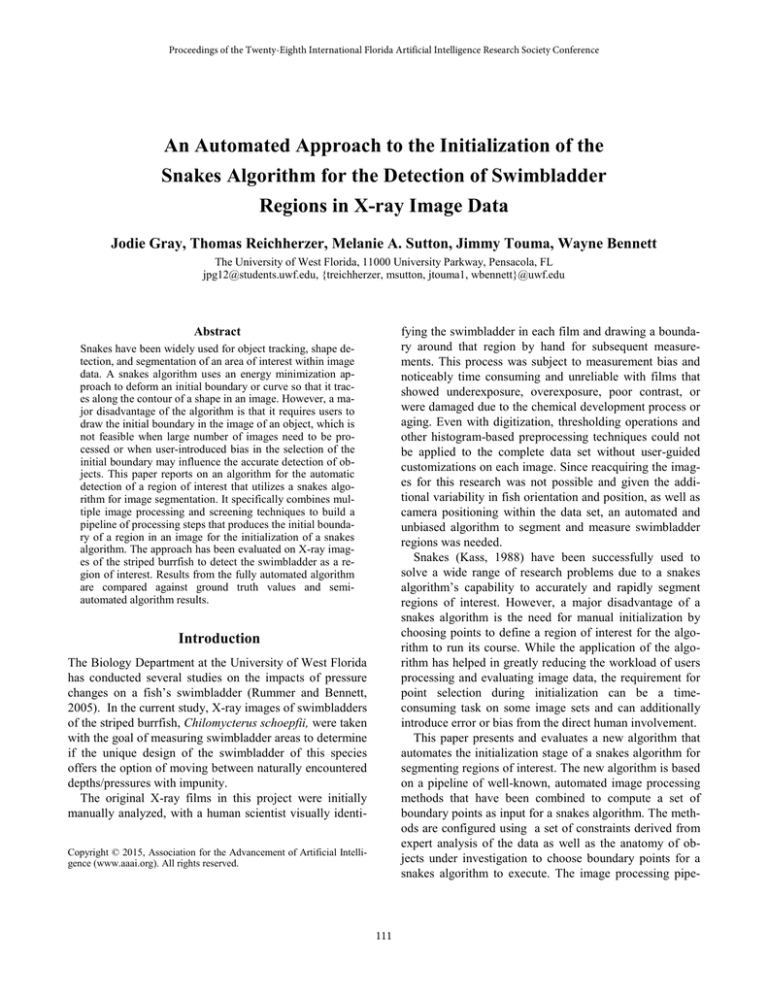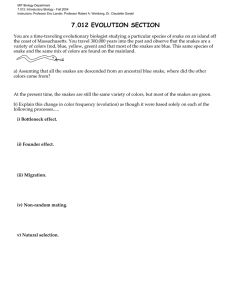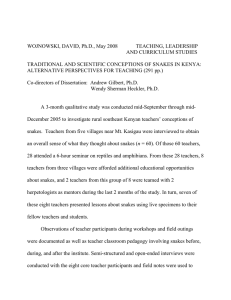
Proceedings of the Twenty-Eighth International Florida Artificial Intelligence Research Society Conference
An Automated Approach to the Initialization of the
Snakes Algorithm for the Detection of Swimbladder
Regions in X-ray Image Data
Jodie Gray, Thomas Reichherzer, Melanie A. Sutton, Jimmy Touma, Wayne Bennett
The University of West Florida, 11000 University Parkway, Pensacola, FL
jpg12@students.uwf.edu, {treichherzer, msutton, jtouma1, wbennett}@uwf.edu
Abstract
fying the swimbladder in each film and drawing a boundary around that region by hand for subsequent measurements. This process was subject to measurement bias and
noticeably time consuming and unreliable with films that
showed underexposure, overexposure, poor contrast, or
were damaged due to the chemical development process or
aging. Even with digitization, thresholding operations and
other histogram-based preprocessing techniques could not
be applied to the complete data set without user-guided
customizations on each image. Since reacquiring the images for this research was not possible and given the additional variability in fish orientation and position, as well as
camera positioning within the data set, an automated and
unbiased algorithm to segment and measure swimbladder
regions was needed.
Snakes (Kass, 1988) have been successfully used to
solve a wide range of research problems due to a snakes
algorithm’s capability to accurately and rapidly segment
regions of interest. However, a major disadvantage of a
snakes algorithm is the need for manual initialization by
choosing points to define a region of interest for the algorithm to run its course. While the application of the algorithm has helped in greatly reducing the workload of users
processing and evaluating image data, the requirement for
point selection during initialization can be a timeconsuming task on some image sets and can additionally
introduce error or bias from the direct human involvement.
This paper presents and evaluates a new algorithm that
automates the initialization stage of a snakes algorithm for
segmenting regions of interest. The new algorithm is based
on a pipeline of well-known, automated image processing
methods that have been combined to compute a set of
boundary points as input for a snakes algorithm. The methods are configured using a set of constraints derived from
expert analysis of the data as well as the anatomy of objects under investigation to choose boundary points for a
snakes algorithm to execute. The image processing pipe-
Snakes have been widely used for object tracking, shape detection, and segmentation of an area of interest within image
data. A snakes algorithm uses an energy minimization approach to deform an initial boundary or curve so that it traces along the contour of a shape in an image. However, a major disadvantage of the algorithm is that it requires users to
draw the initial boundary in the image of an object, which is
not feasible when large number of images need to be processed or when user-introduced bias in the selection of the
initial boundary may influence the accurate detection of objects. This paper reports on an algorithm for the automatic
detection of a region of interest that utilizes a snakes algorithm for image segmentation. It specifically combines multiple image processing and screening techniques to build a
pipeline of processing steps that produces the initial boundary of a region in an image for the initialization of a snakes
algorithm. The approach has been evaluated on X-ray images of the striped burrfish to detect the swimbladder as a region of interest. Results from the fully automated algorithm
are compared against ground truth values and semiautomated algorithm results.
Introduction
The Biology Department at the University of West Florida
has conducted several studies on the impacts of pressure
changes on a fish’s swimbladder (Rummer and Bennett,
2005). In the current study, X-ray images of swimbladders
of the striped burrfish, Chilomycterus schoepfii, were taken
with the goal of measuring swimbladder areas to determine
if the unique design of the swimbladder of this species
offers the option of moving between naturally encountered
depths/pressures with impunity.
The original X-ray films in this project were initially
manually analyzed, with a human scientist visually identiCopyright © 2015, Association for the Advancement of Artificial Intelligence (www.aaai.org). All rights reserved.
111
line can be easily adapted to other image data that require
segmentation of a region of interest by reconfiguring the
individual stages using a different training data set.
The remainder of the paper describes work related to the
research, the data set used for training and testing, the different processing steps of the pipeline, and an evaluation of
the algorithm. The paper concludes with a discussion of
results and future directions for the research.
Related Work
Figure 1: Lateral X-ray of non-inflated burrfish.
Snakes have been widely used to solve segmentation problems in image data. Successful applications of a snakes
algorithm on marine biology data have aided researchers
by automating parts of the evaluation of research results
(Blaschko et al., 2005; Kreho et al., 1999), thereby reducing the time to complete experimentation and the possible
introduction of errors due to factors such as bias and fatigue compared to manual evaluation only. Use of a snakes
algorithm in conjunction with automated enhancements has
also made its presence felt in other imaging domains, such
as aerial image analysis applications for automated contour
correction of roadways (Klinger, 2010). Work closely related to ours includes a sample application of automatically
assisted snakes segmentation in medical image data
(Zhang, 2007). The application computes the initial starting points for a snakes algorithm for polar edge detection
on images of human tongues. However, the presented
methods in this paper differ from the tongue approach in
that the burrfish pipeline uses fewer preprocessing stages,
and the constraints for each stage are easily modifiable for
use in other types of image data.
Figure 2: Dorsal X-ray featuring low image contrast.
For the development of the automated algorithm, the
data was split into a training and a testing set. The training
set was used to configure the different stages of the image
processing methods in the pipeline; the testing set was used
to compare the results of the algorithm against a domain
expert's results of detected swimbladders. Images used for
the training set consisted of 3 images taken from the lateral
view which depicted one visible swimbladder in each image and 2 images taken from the dorsal view which each
depicted two visible swimbladder regions. This overall
training set thus consisted of 5 images covering 7
swimbladder regions to be detected. The remaining 60 images were utilized for testing of the developed algorithm.
From the training set, allowable dimensions for
swimbladder size and placement within the fish were derived for use across the full data set during testing. Measurements based on expected burrfish anatomy yielded allowable swimbladder major axis dimensions to be within
1/5 – 1/2 of total fish body length.
X-ray Image Data of the Striped Burrfish for
Building a Swimbladder Detection Algorithm
The complete data set used for developing and evaluating
the swimbladder detection algorithm includes 65 X-ray
images taken from the dorsal and lateral views of the
striped burrfish as each one is exposed to variations in
pressure conditions simulating different depths of water.
Figures 1 and 2 illustrate sample data of the striped
burrfish from both the lateral and dorsal view with different image contrasts. As the figures illustrate, the
swimbladder (darker shaded regions within the fish) is in
some cases extremely difficult to detect and requires significant domain knowledge of the approximate size and
location of the swimmbladder region to be able to detect
and mark it in the images with high accuracy for subsequent measurements of its size.
An Architecture for Automated Snake
Initialization
The automated initialization pipeline consists of three preprocessing stages as well as a preliminary stage (0) that is
specifically designed for detecting swimbladders in fish.
The constraints applied to each stage are customized for
use in swimbladder detection. However, these constraints
are easily exchangeable for other constraints to perform
112
different segmentation tasks in other data sets. The complete algorithm of the pipeline was developed in C++ with
the help of the Open source Computer Vision (OpenCV)
programming library version 2.4.6.
age. A voting algorithm is employed to sort through all
candidate blobs and determine the most likely position and
dimensions of the region representing the swimbladder
area. Voting is accomplished through use of a binning
technique that rounds x and y coordinates to units of 10
pixels and angle measurements to units of 10 degrees.
Counting of blobs in each bin is subsequently used to implement the voting scheme.
Blob size, location, orientation, and relationship to other
blobs (dorsal images only) are used as comparisons among
candidate blobs. Previously binned and counted blobs are
evaluated by these measures, and outliers are eliminated
using expected (a) blob position and (b) blob major axis
orientation for the object of interest. False candidate blobs
are eliminated based on allowable blob sizes, as determined by fish body size constraints learned from stage 0 of
the algorithm.
Stage 0: Narrowing of search window
The preliminary stage of the snake initialization process is
used to identify a search window within the striped
burrfish X-ray where a swimbladder is to be expected. This
stage may therefore not be required in data sets that exhibit
better image positioning consistency. For this data set, a
simple feature detection algorithm is used to identify the
fish’s body cavity through detection of mouth and tail regions and thus limit the search window to only search for
regions of interest that are bounded by the fish’s body cavity.
Stage 1: Thresholding and Blob Detection
Stage 3: Initial Snake Placement
As the first stage of the automated pipeline, binary
thresholding is performed at several threshold values, with
blob detection performed at each iteration. Thresholding
across several values is used to highlight distinct features
(blobs) that are present across multiple threshold values
and distinguish these features from artifacts that may appear in the image. Figures 3 and 4 illustrate the appearance
of true swimbladder regions as elliptical-shaped blobs for
two arbitrary selected threshold values.
At the conclusion of stage 2 a single region that defines the
most likely swimbladder region and its dimensions are
determined and ready to be segmented by a snakes algorithm. The initial snake placement stage chooses coordinates immediately “next” to the identified region of interest
to run a traditional contour algorithm. Initial snake points
are assigned as a rectangular (rotated, where necessary)
boundary that is slightly larger than the size of the region
of interest in order to enclose all of the desired area. At the
completion of the initial coordinate assignment, the traditional form of a snakes algorithm is executed on the
thresholded image.
Experiments and Results
Results generated by the swimbladder detection algorithm
on training images were compared to human-generated
ground truth images. Ground truth images were produced
collaboratively by two domain experts and were created by
various manual pre-processing methods to enhance
swimbladder appearance, followed by hand labeling of the
actual swimbladder boundary.
Accurate region of interest identification occurred for 5
of the 7 cases with a success rate of 71.4% for the training
set. Cases of failure always occurred at stage 1 of the automated pipeline where candidate regions are identified
based on elliptical fitting and blob dimension constraints.
All cases of failure resulted in the identification of zero
candidate regions at stage 1, thus no false positive results
were generated from trials of the training set. Cases of success (5 of the 7) indicate 100% success for each stage in
the automated pipeline, and cases of failure (2 of the 7)
indicate stage 1 of the pipeline as the most sensitive stage,
Figure 3: Thresholding X-ray image with a value of 92.
Figure 4: Thresholding X-ray image with a value of 180.
Stage 2: Blob Identification
At stage 2, candidate blobs attained from stage 1 are evaluated based on their dimensions and location within the im-
113
with the assumption that this was due to the large variations in image quality.
Figures 8 and 9 below illustrate an example comparison
of the human ground truth identification and the fully automated algorithm result on a selected training image.
Conclusions and Future Work
This paper proposes and evaluates an initialization method
for use in conjunction with the traditional implementation
of the snakes algorithm to identify and segment
swimbladder regions from X-ray images of the striped
burrfish. The approach is unbiased and fully-automated,
and its evaluation shows promising results demonstrated
by average measurement differences ranging from approximately 13-39%.
Total run time for the fully automated method (approximately 6 seconds on large 1000 x 2000 pixel images) presented a significant improvement in swimbladder identification and segmentation time compared to the manual
method (approximately 1 hour) involving two domain experts. Use of the automated algorithm also eliminates detection and measurement bias that may be introduced by
human researchers. This research may therefore also be
useful to other marine biologists with similarly challenging
image sets where a traditional application of a contour algorithm failed (Cocito et al., 2003).
Future work includes further analysis of the robustness
of the automated pipeline and application of additional preprocessing steps to help the method accurately analyze a
broader range of input image quality.
Figure 8: Human-generated ground truth segmentation of
swimbladder in lateral view.
References
Figure 9: Fully automated identification and segmentation result.
Blaschko, M. B., Holness, G., Mattar, M. A., Lisin, D., Utgoff, P.
E., Hanson, A. R., and Tupper, B. 2005. Automatic In Situ Identification of Plankton, 79-86. In Proceedings of Application of
Computer Vision. IEEE.
Cocito, S., Sgorbini, S., Peirano, A., and Valle, M. 2003. 3-D
Reconstruction of Biological Objects Using Underwater Video
Technique and Image Processing. Journal of Experimental Marine Biology and Ecology 297:57-70.
Kass, M., Witkin, A., and Terzopoulos, D. 1988. Snakes: Active
Contour Models. International Journal of Computer Vision
1:321-331.
Klinger, T., Ziems, M., Heipke, C., Schenke, H. W., and Ott, N.
2011. Antarctic Coastline Detection Using Snakes.
Photogrammetrie-Fernerkundung-Geoinformation 2011:421-434.
Kreho, A., Kehtarnavaz, N., Araabi, B., Hillman, G., Würsig, B.,
and Weller, D. 1999. Assisting Manual Dolphin Identification by
Computer Extraction of Dorsal Ratio. Annals of Biomedical Engineering 27:830-838.
Rummer, J. L., and Bennett, W. A. 2005. Physiological Effects of
Swim Bladder Overexpansion and Catastrophic Decompression
on Red Snapper. Transactions of the American Fisheries Society
134:1457-1470.
Zhang, H., Zuo, W., Wang, K., and Zhang, D. 2006. A Snakebased Approach to Automated Segmentation of Tongue Image
Using Polar Edge Detector. International Journal of Imaging
Systems and Technology 16:103-111.
The criteria for measuring success for the fully automated
algorithm are shown in Figure 12 where measurements of
detected swimbladder regions from the 60-image testing
set are compared between the fully-automated and manually initialized algorithm.
38.5
15.2
Area
18.3
12.5
Major
axis
Minor
axis
11.6
Major
axis
angle
Minor
axis
angle
Figure 12: Average % difference measurements between
manually initialized snake and fully-automated snake on testing
data set.
114








